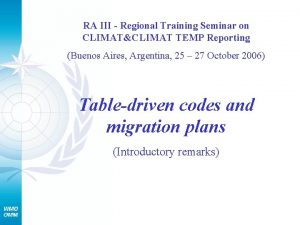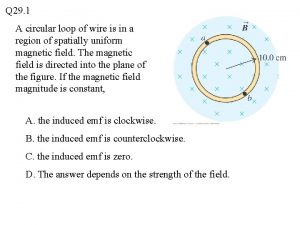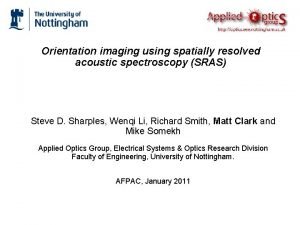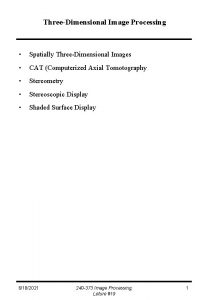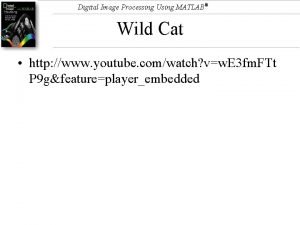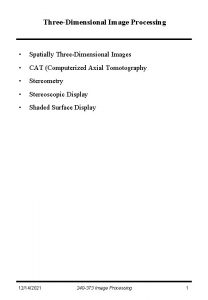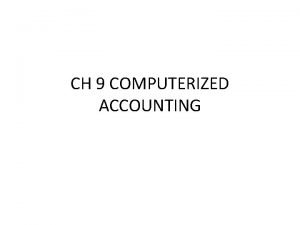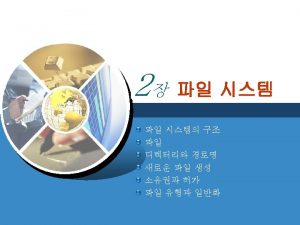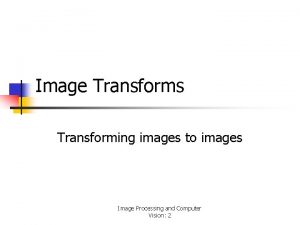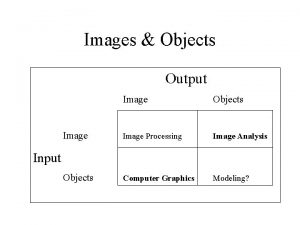ThreeDimensional Image Processing Spatially ThreeDimensional Images CAT Computerized








- Slides: 8

Three-Dimensional Image Processing • Spatially Three-Dimensional Images • CAT (Computerized Axial Tomotography • Stereometry • Stereoscopic Display • Shaded Surface Display 6/18/2021 240 -373 Image Processing, Leture #19 1

Three-Dimensional Imaging • Optical sectioning – Problem with conventional optical microscope: only structure near the focus plane is visible – Serial sectioning (slicing the specimen into a series of thin sections and acquiring the image of each section) can be used to solve the problem but it has 2 major disadvantages: • loss of registration when sections become separated • geometric distortions – Optical sectioning is achieved by digitizing the specimen with the focal plane situated at various levels along the optical axis • Thick specimen imaging 6/18/2021 240 -373 Image Processing, Leture #19 2

Thick specimen imaging (cont’d( – The focal length of the objective lens determines the distance df to the focal plane from the lens equation: /1 di = 1/df = 1/f and the magnification of the objective is M = di / df We can place the focal plane at any desired level z’. The focal plane of the objective is related th the other microscope parameters by f = di/(M+1) = (df. M)/(M+1) = (didf)/(di+df( and the distance from the center of the lens to the focal plane is df = di/M = (M+1)f/M = fdi/(di-f( • Deblurring optical section images 6/18/2021 240 -373 Image Processing, Leture #19 3

Computerized Axial Tomography (CAT( • Conventional radiography – Using X-rays – Some structures in human body absorb X rays more heavily than other structures – No lenses are used – Projection (2 dimensional) of the object is recorded – Multiple views are frequently used to resolve ambiguities • Tomography – Useful where image detail is required in deeply imbedded structures such as those of the middle ear – One disadvantage: high dosage of X-ray 6/18/2021 240 -373 Image Processing, Leture #19 4

• Computerized axial tomography (CAT( – CAT is a technique that incorporates digital image processing to obtained 3 -D images – The CAT scanner rotates about the object to acquire a series of exposures – The resulting set of 1 -D intensity functions is used to compute a 2 -D cross-sectional image of the object at the level of the beam – The beam is moved down the object in small steps producing a 3 -D image 6/18/2021 240 -373 Image Processing, Leture #19 5

Stereometry • Stereometry is a technique by which one can deduce the 3 -D shape of an object from a stereoscopic image pair • Image of the object can be recorded by measuring the brightness of each pixel on the image plane • The distance from the center of the lens to the point p defines the range of this pixel • A range image can be generated by assigning each pixel a gray level proportional, not to its brightness, but to the length of its pixel cone 6/18/2021 240 -373 Image Processing, Leture #19 6

Stereoscopic Imaging • Range equations – Suppose that the point P, with coordinates (X 0, Y 0, Z 0) is located in front of the cameras – We can show that a line from P through the center of theleft camera will intersect the Z = -f plane at – Similarly for the right camera – We now setup a 2 -D coordinate system in each image plane with a 180 o rotation, thus 6/18/2021 240 -373 Image Processing, Leture #19 7

Range equations (Cont’d( – Now the coordinate of the point images are and Rearranging both equations Solving for Z 0, gives the normal-range equation. – We can also write Substitute Z 0 gives the true-range equation: 6/18/2021 240 -373 Image Processing, Leture #19 8
